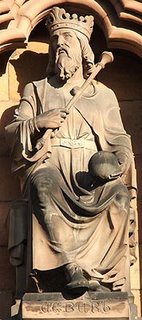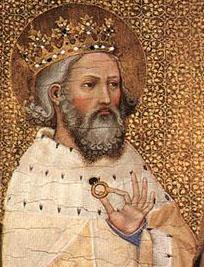1066 and All That

William I, king and conqueror of England, died on this day in Rouen in 1087 at the age of about 59.
William was the bastard son of Robert, Duke of Normandy, by the daughter of a tanner whom Robert met and fell in love with at a dance. When William was 8 his father died, leaving William as a young duke in the hands of stewards and tutors. While many of his protectors lost their lives to treachery, William survived to adulthood in part with the help of Henry I of France, yet he gained considerable skill as a combatant while he was growing up. When he was 18, the Normans revolted against his rule, and with Henry's help he managed not only to put down the rebellion but to expand his territory.
In 1051 he began to cast his eye across the English Channel, where his elderly distant cousin Edward the Confessor ruled without an heir. Meeting with Edward, William secured (or at least thought he secured) Edward's promise that William should be the King of England after Edward's death. To shore up his chances, William captured Harold Godwinson, the powerful Earl of Wessex, and extracted a similar promise from him. Nevertheless, Harold considered himself under polite duress, and privately believed that the Normans were no match for his superior Anglo-Saxon forces, should the question ever come up in battle.
Edward died on January 5, 1066, and within 24 hours Harold had himself proclaimed King of England, despite his promise to William. Infuriated by Harold's lack of chivalry, William gathered an army and with the support of Pope Alexander II (who was impressed with William's commitment to monastic reform), William landed on the beach at Pevensey, wearing around his neck the relics upon which Harold had sworn his allegiance to William as a stern reminder.
Harold's Anglo-Saxon army were initially busy in the North fighting Danes, but marched to meet William at the Battle of Hastings. The Anglo-Saxons were well positioned and initially did some damage to William's army, unseating William from his own horse three times. Concerned that his soldiers would think he had been killed, William fought much of the battle bare-headed. He countered Harold's initial success by drawing the Anglo-Saxons into a valley and instructing his archers to change from a flat trajectory to a high angle for maximum penetration. As the battle approached a stalemate, one of the Norman arrows mortally wounded Harold (some say in the eye), and the English retreated.
From Hastings William tried to enter London, and was initially repulsed. After some thought, however, the people of London gave in (due to a lack of credible candidates to fill Harold's void), and crowned him King of England on Christmas Day, 1066 at Westminster Abbey.
For the next five years, William ruthlessly and stubbornly put down a series of minor rebellions in England, and gradually turned to governing. Although the Norman culture was somewhat backward compared to that of the Anglo-Saxons, the inquisitive, imitative Normans adopted much of what they had conquered, even as William installed his own Norman noblemen in English earldoms and his own church leaders in positions of authority. In 1086, William showed his sense of statesmanship by commissioning the Domesday Book, a leviathan survey of people, lands and property throughout England which became a veritable handbook for generations of his descendants who ruled there.
William, who grew stout and bald in middle age, died as a result of an injury he suffered while skirmishing with the army of Philip I at Rouen. He was succeeded in England by his boorish son William Rufus.
Judging by the persistence of William the Conqueror's popularity over the years, it is as if one might imagine that all English history is traceable to William's conquest at Hastings in 1066, and everything occurring before it lies in the obscurity of the Dark Ages.
Labels: Anglo-Saxon England, Kings and Queens



















